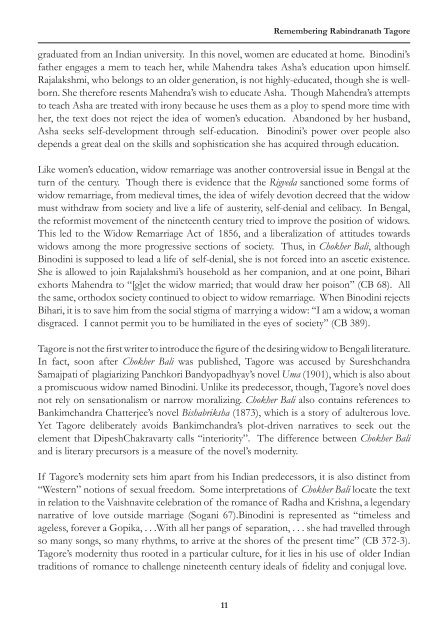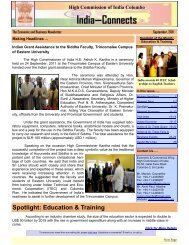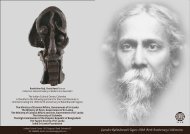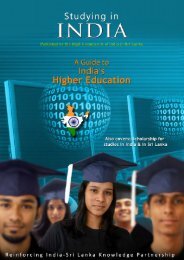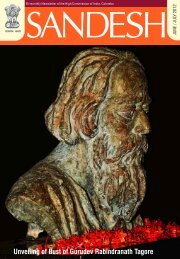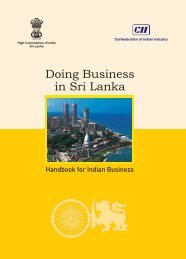Remembering Rabindranath Tagore Volume - High Commission of ...
Remembering Rabindranath Tagore Volume - High Commission of ...
Remembering Rabindranath Tagore Volume - High Commission of ...
You also want an ePaper? Increase the reach of your titles
YUMPU automatically turns print PDFs into web optimized ePapers that Google loves.
11<br />
<strong>Remembering</strong> <strong>Rabindranath</strong> <strong>Tagore</strong><br />
graduated from an Indian university. In this novel, women are educated at home. Binodini’s<br />
father engages a mem to teach her, while Mahendra takes Asha’s education upon himself.<br />
Rajalakshmi, who belongs to an older generation, is not highly-educated, though she is wellborn.<br />
She therefore resents Mahendra’s wish to educate Asha. Though Mahendra’s attempts<br />
to teach Asha are treated with irony because he uses them as a ploy to spend more time with<br />
her, the text does not reject the idea <strong>of</strong> women’s education. Abandoned by her husband,<br />
Asha seeks self-development through self-education. Binodini’s power over people also<br />
depends a great deal on the skills and sophistication she has acquired through education.<br />
Like women’s education, widow remarriage was another controversial issue in Bengal at the<br />
turn <strong>of</strong> the century. Though there is evidence that the Rigveda sanctioned some forms <strong>of</strong><br />
widow remarriage, from medieval times, the idea <strong>of</strong> wifely devotion decreed that the widow<br />
must withdraw from society and live a life <strong>of</strong> austerity, self-denial and celibacy. In Bengal,<br />
the reformist movement <strong>of</strong> the nineteenth century tried to improve the position <strong>of</strong> widows.<br />
This led to the Widow Remarriage Act <strong>of</strong> 1856, and a liberalization <strong>of</strong> attitudes towards<br />
widows among the more progressive sections <strong>of</strong> society. Thus, in Chokher Bali, although<br />
Binodini is supposed to lead a life <strong>of</strong> self-denial, she is not forced into an ascetic existence.<br />
She is allowed to join Rajalakshmi’s household as her companion, and at one point, Bihari<br />
exhorts Mahendra to “[g]et the widow married; that would draw her poison” (CB 68). All<br />
the same, orthodox society continued to object to widow remarriage. When Binodini rejects<br />
Bihari, it is to save him from the social stigma <strong>of</strong> marrying a widow: “I am a widow, a woman<br />
disgraced. I cannot permit you to be humiliated in the eyes <strong>of</strong> society” (CB 389).<br />
<strong>Tagore</strong> is not the first writer to introduce the figure <strong>of</strong> the desiring widow to Bengali literature.<br />
In fact, soon after Chokher Bali was published, <strong>Tagore</strong> was accused by Sureshchandra<br />
Samajpati <strong>of</strong> plagiarizing Panchkori Bandyopadhyay’s novel Uma (1901), which is also about<br />
a promiscuous widow named Binodini. Unlike its predecessor, though, <strong>Tagore</strong>’s novel does<br />
not rely on sensationalism or narrow moralizing. Chokher Bali also contains references to<br />
Bankimchandra Chatterjee’s novel Bishabriksha (1873), which is a story <strong>of</strong> adulterous love.<br />
Yet <strong>Tagore</strong> deliberately avoids Bankimchandra’s plot-driven narratives to seek out the<br />
element that DipeshChakravarty calls “interiority”. The difference between Chokher Bali<br />
and is literary precursors is a measure <strong>of</strong> the novel’s modernity.<br />
If <strong>Tagore</strong>’s modernity sets him apart from his Indian predecessors, it is also distinct from<br />
“Western” notions <strong>of</strong> sexual freedom. Some interpretations <strong>of</strong> Chokher Bali locate the text<br />
in relation to the Vaishnavite celebration <strong>of</strong> the romance <strong>of</strong> Radha and Krishna, a legendary<br />
narrative <strong>of</strong> love outside marriage (Sogani 67).Binodini is represented as “timeless and<br />
ageless, forever a Gopika, . . .With all her pangs <strong>of</strong> separation, . . . she had travelled through<br />
so many songs, so many rhythms, to arrive at the shores <strong>of</strong> the present time” (CB 372-3).<br />
<strong>Tagore</strong>’s modernity thus rooted in a particular culture, for it lies in his use <strong>of</strong> older Indian<br />
traditions <strong>of</strong> romance to challenge nineteenth century ideals <strong>of</strong> fidelity and conjugal love.


